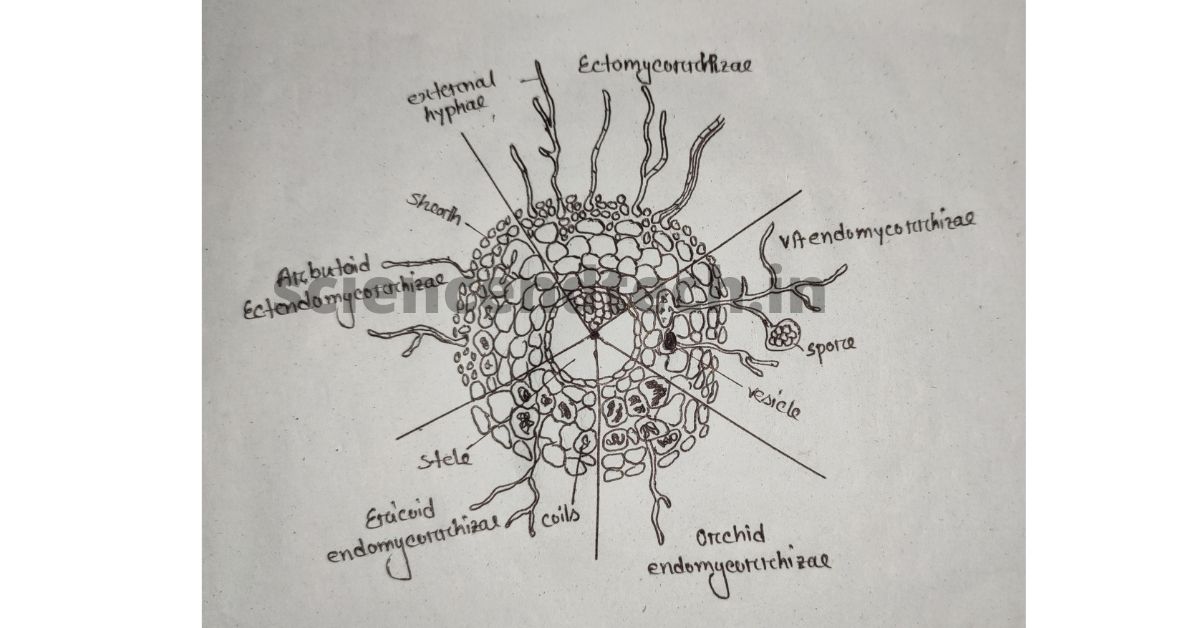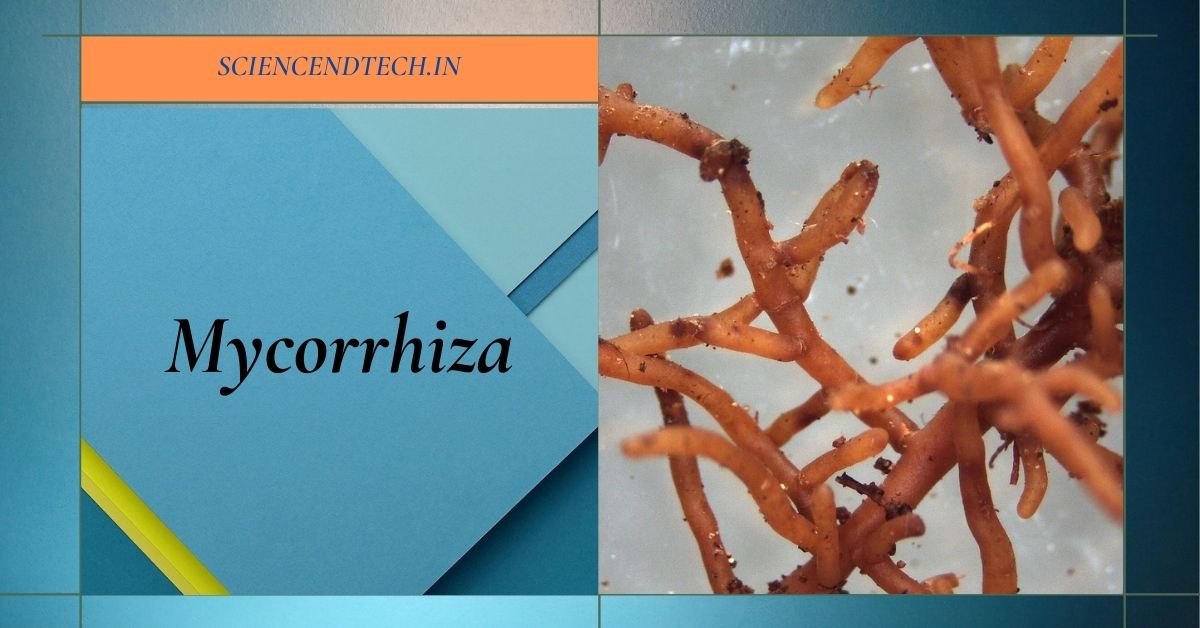Roots of most terrestrial plants form a symbiotic relationship with fugal form, these ubiquitous symbioses are popularly known as Mycorrhizal association or Mycorrhiza. About 90%of land plants show symbiotic arrangements with beneficial performance and have been around for approximately 400 million years.
Introduction
Roots of most terrestrial plants form a symbiotic relationship with fungi, this association is known as Mycorrhiza, where the bidirectional nutrient exchange is established between the two partners.
The host plant, which is autotrophic, acts as the carbon source for the fungus, while fungus supplies mineral nutrients to the plant. Nearly approx. 90% of all land plants are associated with mycorrhiza.
Common features –
- It is very much essential in areas where soils are deficient in water and certain nutrients.
- A larger root system permits the plants to obtain additional moisture and nutrients.
- Plants are less susceptible to water stress.
- Not only do the fungal threads help to bring water and nutrition into the plants.
- But they also store them for use when rainfall is sparse and temperature is high.
- It is very important and necessary in making nutrients available for the plant when composed or organic matter is added to improve soil elements.
Mycorrhiza granules: They are used in some species of wildflowers, to aid plant growth. At the time of planting, they are applied to the planting hole. It is likely the soil bacteria and fungi are lacking or are quite low in number and fungi species if the ground has been improved.
Types of Mycorrhiza
Mycorrhiza are classified into seven distinct types. They are-
- Ectomycorrhiza: Commonly called ‘sheathing mycorrhizae’ mainly found on pine, beech, spruce, birch etc. Here, I found an extensive branching system, growth of roots and modification of branching patterns. The racemose type is found mainly in dicots (Fagus) and dichotomous type mainly in gymnosperm (Pinus). They appear in various colors like white, brown, black etc. depending on the fungus colour. After entering into the cortex the fungus forms a ‘Hartig net’ but never goes inside the endodermis or stele. Most of the members belong to the genera Amanita, Tricholoma, Boletus, Russula, Lactarius etc.
- Vesicular-arbuscular mycorrhiza (VAM): It is also an endomycorrhizal association, where both vesicles and arbuscules are developed together. This type is also found in bryophytes, pteridophytes, gymnosperms (except Pinaceae). And also in some angiosperms, like – Leguminosae, Rosaceae, Poaceae, Arecaceae etc. But this association is not found in Ericaceae and Orchidaceae family members, where other types of association are available.
- Ectendomycorrhiza: This is the intermediary type of ecto- and endomycorrhizal pattern. Mainly found in the family Ericaceae and members of other families of Ericales. Ex – Arbutus and Arctostaphylos of the Ericaceae family show this type. In the case of Arbutus, short roots are swollen and covered by a hyphal mantle and root parts are differentiated into two parts with long and short roots. Here intercellular coils develop in the outer cortical cells but no Hartig net is found.
- Gentianoid mycorrhizae: Here, root cortical cells become full of irregular coils of aseptate hyphae. With time the hyphae become lysed. Vesicles are attached to these coils. Mainly found in some members of Gentianaceae, (Ex- Blackstonia perfoliata, Gentianella amarella, etc). Seedlings of some members get infected within 2weeks of germination (Ex- Gentianaceae).
- Ericoid mycorrhizae: Found in Erica, Calluna, Vaccinum, Rhododendron etc of family Arecaceae. In this type of plant, rootlets are covered by very sparse, loose, dark septate hyphae. And they penetrate the cortex to form intercellular coils. Coils degenerate like arbuscles of vesicular-arbuscular mycorrhizae after 3-4 weeks. In acid soil with less amount of P and N nutrition, most of the members of Ericaceae developed. In this way, fungus improves the mineral uptake and nutrition of the host and gets the photosynthate from the host plant. High tolerance for these metals like – Zn, Cu show in mycorrhizal plants but these are totally absent in non-infected plants.
- Orchidiod mycorrhizae: Orchids produce millions of tiny seeds per capsule. Seeds contain 10-100 cells and there is virtually no storage of food in the embryo. A thin-walled net-like Testa encircled the embryo portion which helps in their dispersal. Thus, the majority of seeds are unable to germinate without an exogenous supply of carbohydrates. This is why the mycorrhizal association is almost mandatory for the seeds to germinate. The fungus provides C-nutrition to the seeds. The fungus enters into the embryo and forms colonisation, and they are restricted to enter into the cortical cells and provide nutrition. On the mycorrhizal fungi, it shows a case of parasitism by orchids. Rhizoctonia (Basidiomycotina), is recognised by hyphal characteristics. And also Corticium, Ceratobasidium etc.
- Monotropoid mycorrhiza: Monotropa hypopitys is a non-green saprophytic herb. This type has short fleshy roots that are invested with a hyphal sheath and forming a Hartig net in the cortical zone portion. They are unable to synthesise because chlorophyll is not present, and they supply carbohydrates to the fungus. In both, the roots of pine and Monotropa, one type of mycorrhizal fungus is associated with Boletus. P32 injected into Monotropa was also deleted in Pine roots within 2hours. Between the plants, indicates a bidirectional flow of nutrients, through the fungal Boletus.

Role
In agriculture
- Formation of dichotomous branching and profuse root growth system, these are the advantages of mycorrhizal association. thus enhances plant growth.
- Act as a reservoir and help in the uptake of mineral ions.
- Absorption of nutrients.
- Helps in the absorption of N, Ca, Zn, Fe and others.
- For the germination of orchid seeds, this association is mandatory.
- Inoculation of VAM as a biofertilizer provides a distinct possibility for the uptake of P in phosphorus-deficient soil.
- Kidson and Lang in 1921, reported the VAM-like organism with Rhynia and Asteroxylon.
- Mycorrhizal association was proposed as a prelude over land plant evolution, by many scientists such as Pyrozinski, Mallock etc.
Role in Forestry
- This type of association was present very early in the evolution of land plants.
- It plays an important role in establishing forests in unfavorable locations, barren land, wastelands etc.
- Facultative endomycorrhizal tree was acting as the first invaders in wastelands, which is performed as pioneers in plant succession.
- Mycorrhizal fungi in forest bed enhances this association purpose.
- As a result, it prevents the entry of fungal root pathogens. This method is very beneficial found in the root of Pinus Clausa against Phytophthora cinnamomi infection.
- It mixed with nitrogenous compounds such as nitrate, ammonia etc. is available to the plants.
- Thus it promotes a plant growth system, especially in acid soil.
That’s it for this post. If you have any query please feel free to comment below. Thank you.
What is VAM?
It is also an endomycorrhizal association, where both vesicles and arbuscules are developed together. This type is also found in bryophytes, pteridophytes, gymnosperms (except Pinaceae).
What is autotrophic?
The host plant, which is autotrophic, acts as the carbon source for the fungus, while fungus supplies mineral nutrients to the plant.

